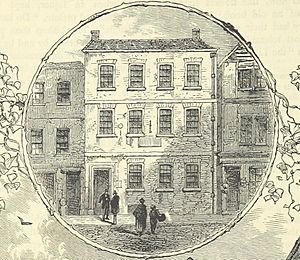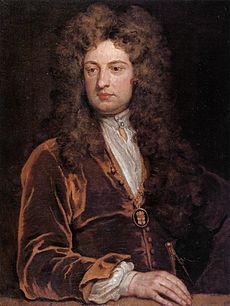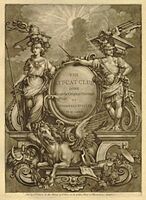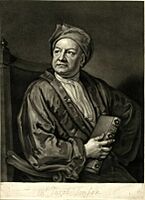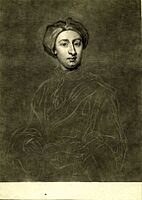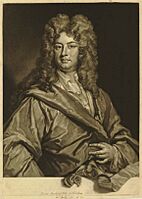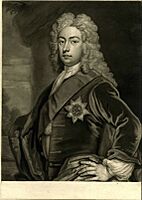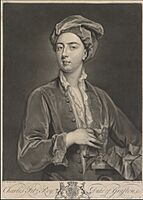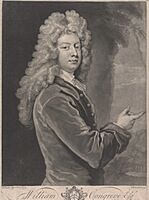Kit-Cat Club facts for kids
The Kit-Cat Club was a famous English club in London during the early 1700s. It was a place where important politicians and writers met. Members of the club were known as Whigs, a political group that believed in a strong Parliament and a limited monarchy. The club first met at the Trumpet Tavern in London and also at Water Oakley in the countryside.
The club's first meetings were held at a tavern in Shire Lane, run by an innkeeper named Christopher Catt. He was famous for his delicious mutton pies, which were called "Kit Cats." Many people believe the club got its name from these popular pies.
Later, the club moved to the Fountain Tavern on The Strand. Eventually, they had a special room built for their meetings at Barn Elms, the home of their secretary, Jacob Tonson. In the summer, the club would meet at the Upper Flask on Hampstead Heath.
Contents
How the Kit-Cat Club Got Its Name
The exact story of how the "Kit-Cat Club" got its name isn't completely clear, but there are a few ideas! One popular idea is that it came from Christopher Catt, the owner of the pie-house where the club first met. His nickname was "Kit," and his famous mutton pies were called "Kit-Kats." These pies were a regular dish at the club's meetings.
Another idea is that the club might have started as the "Order of the Toast." This refers to a special tradition of the Kit-Cat Club: they would drink toasts to the most beautiful and admired ladies of the day. They even had special glasses with poems engraved on them in praise of these ladies.
A famous short poem by Dr. Arbuthnot playfully mentions the different ideas about the name:
Whence deathless Kit-Kat took his name
Few critics can unriddle
Some say from pastrycook it came
And some from Cat and Fiddle.
From no trim beaus its name it boasts
Grey statesmen or green wits
But from the pell-mell pack of toasts
Of old Cats and young Kits.
What the Club Believed In
Some historians think the Kit-Cat Club started even before the Glorious Revolution of 1688. This was a very important time in English history when the power of the king was limited, and Parliament became stronger.
The club's main goals were to support a strong Parliament, a king or queen with limited power, and to resist the influence of France. They also strongly supported the Protestant succession to the throne, meaning they wanted a Protestant ruler to follow the previous one.
Horace Walpole, whose father was a Kit-Cat member, once said that the club was "generally mentioned as a set of wits, in reality the patriots that saved Britain." This shows how important their political ideas were considered.
Famous Members of the Club
The Kit-Cat Club had many important and talented members. These included famous writers like William Congreve, John Locke, Sir John Vanbrugh (who was also a famous architect), and Joseph Addison.
Many powerful politicians were also members, such as the Duke of Somerset, the Earl of Burlington, and Sir Robert Walpole, who later became a very important leader in Britain.
One special member was the artist Sir Godfrey Kneller. He painted portraits of 48 club members over more than twenty years. These paintings are very famous because they are all a specific size, known as the "kit-cat" format (36 by 28 inches). These portraits give us a great look at who was part of this important club. Many of these portraits can be seen today at Beningbrough Hall in North Yorkshire.
The Club's Toasts
The Kit-Cat Club was well-known for its tradition of "toasting" ladies. This meant they would raise their glasses and drink to honor a beautiful or important woman of the time. We know the names of some of the ladies they toasted:
- Lady Mary Wortley Montagu
- Lady Godolphin
- Lady Sunderland
- Lady Bridgewater
- Lady Monthermer (all daughters of the famous John Churchill, 1st Duke of Marlborough)
- The Duchess of Bolton
- The Duchess of Beaufort
- Catherine Barton, who was Newton's niece.
The names of these toasted ladies were often engraved on the glass goblets used for the toasts.
Notable Members List
- Joseph Addison
- James Berkeley, 3rd Earl of Berkeley
- Richard Boyle, 3rd Earl of Burlington
- Richard Temple, 1st Viscount Cobham
- William Congreve
- Charles Dartiquenave
- William Cavendish, 2nd Duke of Devonshire
- Lionel Sackville, 1st Duke of Dorset
- Samuel Garth
- Charles FitzRoy, 2nd Duke of Grafton
- Evelyn Pierrepont, 1st Duke of Kingston-upon-Hull
- Godfrey Kneller
- Charles Montagu, 1st Duke of Manchester
- Charles Mohun, 4th Baron Mohun of Okehampton
- Thomas Pelham-Holles, 1st Duke of Newcastle
- Charles Lennox, 1st Duke of Richmond
- Charles Seymour, 6th Duke of Somerset
- James Stanhope, 1st Earl Stanhope
- Abraham Stanyan
- Richard Steele
- Charles Spencer, 3rd Earl of Sunderland
- John Vanbrugh
- Robert Walpole
- Thomas Wharton, 1st Marquess of Wharton
The Kit-Cat Club Portraits
The famous artist Godfrey Kneller was asked to paint portraits of the club's members. He decided to use a special size for these paintings, which became known as the 'kit-cat' format (36 x 28 inches). This size was larger than typical portraits of the time.
In the 1730s, these portraits were displayed in a special room that Jacob Tonson junior built at his home in Barn Elms.
- Mezzotint portraits of the members of the Kit Cat Club by John Faber the Younger after Sir Godfrey Kneller (selection from the total of 47)
-
Mezzotint title page from the Kit Cat Club portraits by John Faber the Younger, 1735. British Museum
-
Mezzotint portrait of Jacob Tonson by John Faber the Younger after Sir Godfrey Kneller, 1733. British Museum
-
Mezzotint portrait of Theophilus Hasting, Earl of Huntingdon by John Faber the Younger after Sir Godfrey Kneller, 1733 British Museum
-
Mezzotint portrait of Charles Montagu, Earl of Halifax by John Faber the Younger after Sir Godfrey Kneller, 1733 British Museum
-
Mezzotint portrait of Sir John Vanbrugh by John Faber the Younger after Sir Godfrey Kneller, 1733. British Museum
-
Mezzotint portrait of Richard Boyle, Earl of Burlington by John Faber the Younger after Sir Godfrey Kneller, 1733. British Museum
-
Mezzotint portrait of Charles FitzRoy, 2nd Duke of Grafton by John Faber the Younger after Sir Godfrey Kneller, 1733. Yale Center for British Art
-
Mezzotint portrait of William Congreve Esq by John Faber the Younger after Sir Godfrey Kneller, 1733. Yale Center for British Art
See also
- The Scriblerian and the Kit-Cats


